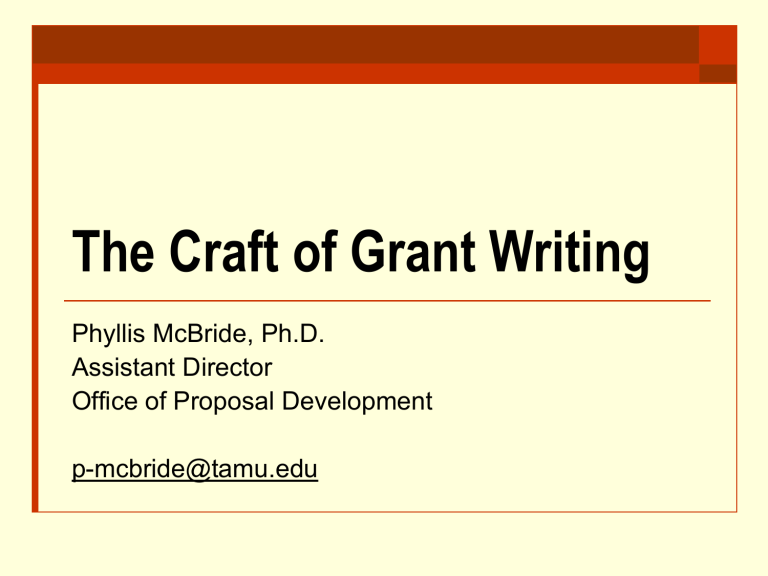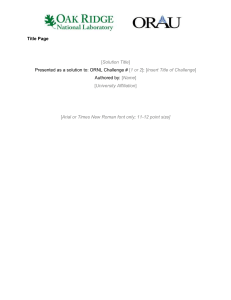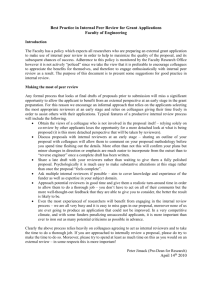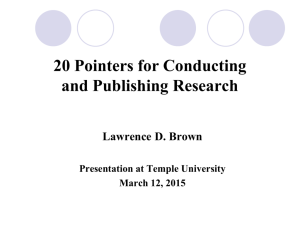The Craft of Grant Writing

The Craft of Grant Writing
Phyllis McBride, Ph.D.
Assistant Director
Office of Proposal Development p-mcbride@tamu.edu
Writing for reviewers
Think about your reviewers
Remember that while your application will be submitted to an agency, it will be read by people
Prepare your application with your reviewers in mind
Think about your reviewers
Smart
Accomplished
Dedicated
Fair
Think about your reviewers
Busy
Overworked
Tired
Skeptical
Think about your reviewers
“Distinguishing between innovations that emerge from empirical testing of concepts and pre-existing notions and practices currently embraced by businesses to distinguish themselves from competitors in a given local consumer market illustrates the extent to which competitive incentives to offer new and potentially innovative products may encourage such businesses to adopt practices from other markets, thereby avoiding costs associated with research and development of those new products.”
– Example from GWSW
Think about your reviewers
“We will use the previously designed data collection instrument, described in section B.3.1 on page 16, and the statistical analysis, similar to that which is in the methods section of the reprint attached as appendix VI, to measure the extent to which our healthcare assessments approaches will be reflective of the community standards described in Section B.2.1 on page
5.”
– Example from GWSW
Write for your reviewers
“In language, clarity is everything.”
– Confucius
Write for your reviewers
Make sure that all of your reviewers – no matter what kind or level of expertise they may have – will be able to follow your argument
You want your reviewers to be your advocate
For reviewers to be your advocate, they must be able to understand your proposed research project well enough to explain it to other reviewers
Write for your reviewers
Remember that the proposal is the only reality
Assume nothing
Include everything the reviewers will need to evaluate your proposed research and your qualifications to conduct that research
Remember that you are telling a story
Synthesize all key concepts for the reviewers
Clearly articulate the links between the overall goal, the individual objectives, the hypotheses, the rationale, the expected outcomes, and the significance and impact
Don’t count on the reviewers to make leaps of logic for you
Create a reviewer-friendly application
Prepare reviewer-friendly text
Develop reviewer-friendly formatting
Incorporate reviewer-friendly graphics
Create reviewer-friendly text
Divide the proposal into the required sections
Place the sections in the required order
Use parallel structure at the section level
Incorporate logical paragraph breaks
Open paragraphs with clear topic sentences
Avoid the use of inflated language
Use declarative sentences
Define potentially unfamiliar terms
Spell out acronyms and abbreviations
Employ appropriate style and usage
Use correct grammar, punctuation, spelling
Run a spell check and proofread the application
Create a reviewer-friendly format
Observe page limitations
For whole proposal
For individual proposal sections
Observe margin requirements
Observe font and point size requirements
Incorporate headings and subheadings
Incorporate ample white space
Create reviewer-friendly graphics
Make graphics large enough to be useful
Place graphics as close to the text they are meant to illustrate as possible
Refer to graphics in the text
Number and title all graphics
Prepare a caption for all graphics
Label axes and data points, as needed
Provide a legend, as needed
Reading the proposal solicitation
Read the instructions
Read the instructions!
Read all of the instructions!
Read all of the instructions carefully !
Read all of the instructions carefully again !
Agency’s proposal preparation guide
Program’s proposal solicitation
Solicitation’s supplemental instructions
Analyze the solicitation
The proposal solicitation is not :
A list of suggestions
A menu or smorgasbord from which you can choose what to address
The proposal solicitation is :
A non-negotiable list of proposal requirements
A treasure map
Analyze the solicitation
Use information presented in the announcement to help you develop a competitive proposal strategy
Remember that a proposal is a persuasive
“sales” document
Emphasize hot buttons
Echo language of announcement
Address the review criteria
Call your program manager with questions
Preparing the application
Prepare the application
Cover sheet
Title
Abstract
Executive summary
Background
Significance
Project description
Project schedule
Biographical sketch
Resources
Grant support
Budget
Budget justification
Supplementary materials
Cover Sheet
Requires that you provide basic information
Program name and number
Principal investigator information
Administrative official information
Organization name and type
Requested award amount
Proposed project period
Human and animal subjects assurance numbers
Signatures
Oftentimes offers you the opportunity to indicate if you are a “new investigator”
Title
Create a good first impression
Must be informative
Must be interesting
Conform to restrictions on length
Know if restrictions apply to characters only, or to characters and spaces
Conduct market research
Ask colleagues to help you select the most compelling title
Abstract
Provides a concise overview of the proposed project
Requires that you provide a great deal of information within a tightly prescribed format
Who, what, when, where, why, and how
Additional agency-specific information
NIH
– Relevance of the research to public health
NSF – Intellectual merit and broader impacts
Frequently becomes public record if the project is funded
Should be written in third person
Should not include confidential or proprietary information
Introduction / executive summary
Critically important
Often the only part of the proposal that all reviewers will have an opportunity to read
Must be able to stand alone
Must be clearly written
Must provide a conceptual overview
Must generate enthusiasm
Serves as a roadmap to the application
First paragraph
Introduce the project
Relate the project to the agency’s mission
Educate the reviewer
Summarize the important knowns
Identify the gap in the knowledge and/or state the critical need
Explain why the gap or need presents a problem
Remember:
You must present a way to solve the problem or fill the need
Second paragraph
Describe your long-term research goal
Should support the agency’s mission
State the objective of the proposed research project
Should represent a step toward reaching your long-term goal
Present your central hypothesis or statement of need
If presenting a central hypothesis
Make sure it is a real hypothesis, not a predetermined conclusion, i.e., make sure it can be objectively tested to determine its validity
Explain your rationale
Explain what it will be possible to accomplish when your research is complete
Third paragraph
Describe your qualifications
Special training, and/or expertise
Quantity and quality of preliminary data
Unique approach, technology
Describe your research environment
Access to unique equipment and resources
Access to research subjects
Collaborations and partnerships
Fourth paragraph
Delineate your objectives / specific aims
Provide a reasonable number of objectives
Don’t be under- or over-ambitious
Present objectives in a logical order
Make sure each objective can stand alone
Make sure no objective is dependent on the successful completion of another objective
Provide conceptual objectives that focus on your idea rather than descriptive objectives that focus on tasks
Fifth paragraph
Describe the project’s innovation
Delineate the project’s expected outcomes
List specific deliverables
Summarize the project’s significance / impact
Fill a gap in the knowledge
Advance the field
Meet a need
Provide an application
Background
Demonstrate your familiarity with the field
Provide a context for the proposed project
Literature review
Preliminary studies
Literature Review
Cite only literature relevant to the proposed project
Don’t try to be comprehensive
Provide a critical review of the relevant literature
Don’t simply summarize contributions
Situate your proposed research project in the field
Explain how your proposed research project will contribute to and/or advance the field; don’t expect reviewers to make this leap for you
Preliminary Studies
Provide an account only of the preliminary studies relevant to the proposed research project
Determine how much preliminary data to include
Published studies
Summarize the results and provide offprints in the appendix
Unpublished studies
Describe the results in more detail to assure reviewers of the reliability of the results
Present the results in a logical order
Illustrate the results with graphics
Project Description
Organize the project description around the objectives
Try to devote an equal number of pages to each of the objectives
Use parallel structure to describe each of the objectives
Project Description
Title of objective
Introduction to objective
Hypothesis or statement of need
Strategy
Rationale
Project / experimental design for objective
Emphasize concept
Be specific when describing approach / methodology
Refer to your previous work, if appropriate
Expected outcomes for objective
Express confidence
Anticipated problems for objective
Provide solutions and/or alternative strategies
Project schedule
Indicate anticipated start date
Obtain this date from the proposal solicitation
Delineate key milestones
Base milestones on the objectives
Incorporate agency and program requirements
Include dates for reports and other deliverables
Project Schedule
Year 1 Year 2
Task
Objective 1:
Evaluate the extent to which John of
Rupescissa drew upon, and expanded, the research of his contemporaries
Transcribe and collate manuscripts
Translate manuscripts
Analyze manuscripts
Q1 Q2 Q3 Q4 Q1 Q2 Q3 Q4
Biographical Sketch
Highlight accomplishments that demonstrate your capacity to conduct and manage the project
Adhere to agency’s formatting requirements
Use the required form (if applicable)
Follow the prescribed page limits
Include the required headings
Place information in the required order
If you are collaborating
Format your colleagues’ resumes like your own
Biographical Sketch
Name
Title
Institutional affiliation
Education
Field of study, degrees, years degrees were earned
Professional appointments
Department, institutional affiliation, term of appointment
Publications
Full bibliographic citations
Verify if inclusion of publications in press or submitted is allowed
Grant awards
Completed, ongoing, and pending support
Collaborators
Co-authors, co-editors, advisors, advisees
Resources
Demonstrate that it is feasible to conduct the proposed research project at your institution
Facilities
Office, laboratory, library
Equipment and instrumentation
Clinical
Animal
Computer
Other
Demonstrate that you are part of an intellectually stimulating and supportive research environment
Collaborations and partnerships
Affinity groups
Completed, Ongoing, and Pending Grant Support
Show that you have a clear research agenda
Show that you have been productive on past projects
Presented results of research at professional conferences
Published papers in peer-reviewed journals
Demonstrate that you have sufficient time to conduct and manage the proposed research project
Demonstrate that there is no overlap between one of your already funded projects and your proposed research project
Completed, Ongoing, and Pending Grant Support
Contract number
Principal investigator’s name
Sponsor’s name
Project title
Project period
Project summary
Investigator’s role
Investigator’s percent effort
Annual and/or total direct costs
Budget
Adhere to agency and program requirements
Include only allowable costs
Request what you need to complete the project
Make sure the budget reflects the research project’s objectives, scope, and duration
Base budget on real costs
Remember that reviewers know what things cost
Factor in cost escalations for multi-year projects
Factor in both direct and indirect costs
Budget
Understand typical budget categories
Direct costs
Personnel
Equipment
Materials
Travel
Indirect costs
Budget Justification
Use this section to continue to persuade reviewers that you are a thoughtful investigator
Provide a clear and persuasive explanation of why each budget request is needed
Include sufficient detail
Enables program managers to understand how the budget was calculated so that they can see that the request was reasonable
Allows program managers to negotiate the budget in the most appropriate way
Supplementary Materials
Verify that supplementary materials are accepted
Avoid using supplementary materials to circumvent page limitations
Include only supplementary materials that support the application
Offprints or photocopies of publications
Samples of curricula
Samples of surveys, questionnaires, or data collection instruments
Clinical protocols or informed consent documents
Photographs, graphics, or other media
Letters of support or other endorsements
Vetting, editing, and proofreading the application
Vet your application
Identify colleagues to review the application
Select reviewers carefully
Provide reviewers with the information they need
Proposal solicitation
Complete application
Give reviewers ample time
You want them to conduct a thorough review
You want them to help you catch “fatal flaws”
In scholarship and/or science
In grantsmanship
Review, evaluate, and incorporate feedback
Revise your application
“You will have to write and put away or burn a lot of material before you are comfortable in this medium. You might as well start now and get the necessary work done. For I believe that eventually quantity will make for quality.”
– Ray Bradbury
Edit your application
Set aside the instructions and application for a few days
Re-read the instructions and application
Ensure that you have included all required sections
Confirm that you have placed sections in the required order
Verify that you have addressed all review criteria
Ask yourself if you have told the “story” of your proposed research project in the most clear, compelling, and convincing way possible
Proofread your application
Check for errors
Facts
Spelling
Punctuation
Grammar
Usage
Style
Run a spell check
Route and submit your application
Remember that your institution will submit your application on your behalf
Allocate ample time to route your application for institutional approvals
Allow time to finalize application
Paper submissions
Allow ample time to photocopy, bind, and mail application
Electronic submissions
Allow ample time to e-mail and upload application
Wait for news
And wait . . .
And wait . . .
And wait . . .
Receive review comments
If your proposal is funded, celebrate!
Or, if it is not funded, . . .
Deal with rejection
Deal with rejection
“We have read your manuscript with boundless delight. If we were to publish your paper, it would be impossible for us to publish any work of lower standard. And as it is unthinkable that in the next thousand years we shall see its equal, we are, to our regret, compelled to return your divine composition, and to beg you a thousand times to overlook our short sight and timidity.”
– Rejection slip from a Chinese economic journal
Revising and resubmitting the application
Revise and resubmit your application
Respect the views of reviewers
Review the reviews
Discuss the reviews with senior faculty and with your program manager
Decide whether or not you have a viable project
If you don’t, revise the idea or come up with a new one
If you do, revise and resubmit the application
Verify that the targeted program is the best one for the project
Respond to reviewer comments
Focus on submitting a great proposal
Revise and resubmit your application
“Never give in, never give in, never, never, never, never – in nothing, great or small, large or petty – never give in except to convictions or honor and good sense.”
– Winston Churchill




